|
|
|
Sort Order |
|
|
|
Items / Page
|
|
|
|
|
|
|
| Srl | Item |
| 1 |
ID:
150617


|
|
|
|
|
| Summary/Abstract |
European energy markets have undergone a major transformation as they have advanced towards market liberalisation and it is vital that the details of these developments be carefully examined. The success of liberalisation is based on smart regulation, which has been capable of providing solutions to unforeseen events in the process. Our paper seeks to contribute to existing understanding of the unexpected and collateral effects of the liberalisation process in the power system by examining a natural experiment that occurred in Spain in 2009. In that year, the electricity supply by distribution system operators disappeared. This change in retail market competition, as we demonstrate in this paper, has had an unexpected effect in terms of the system’s balancing requirements. We undertake a rigorous assessment of the economic consequences of this policy change for the whole system, in terms of its impact on final electricity prices.
|
|
|
|
|
|
|
|
|
|
|
|
|
|
|
|
| 2 |
ID:
097459
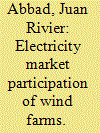

|
|
|
|
|
| Publication |
2010.
|
| Summary/Abstract |
In the last 10 years, more than 15 GW of wind power (Asociación Empresarial Eólica (Spanish Wind Energy Association), Nota de prensa (Press release) 17 de enero de 2008. http://www.aeeolica.org/doc/NP_080117_Espana_supera_los_15000_MW_eolicos.pdf) have been installed in Spain, of which more than 3.5 GW in 2007. Furthermore, plans are to reach 20 GW by 2010 and there are expectations of an installed capacity exceeding 40 GW by 2020. This article will present the innovative solutions for technical and economical integration that allow to reach such high level wind penetration objectives (the system peaks at around 44 GW and is almost isolated). It will be described how the regulation has evolved from a pure Feed-in-Tariff to a market+premium option, where technical and economic integration has been a priority. Today, approximately 97% of installed wind capacity accesses the Spanish wholesale electricity market. Market integration has been crucial, sending the correct signals to participants to look for the optimum technical solutions. Technical improvements have come from both wind power producers (fault-ride-through capabilities, visibility and controllability of wind power, power production forecasting, reactive power control) and the system operator (specific control centre dedicated to Renewable Energy Sources (RES), new security analysis tools, gaining technical confidence of wind capabilities).
|
|
|
|
|
|
|
|
|
|
|
|
|
|
|
|
| 3 |
ID:
096616
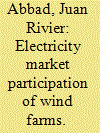

|
|
|
|
|
| Publication |
2010.
|
| Summary/Abstract |
In the last 10 years, more than 15 GW of wind power (Asociación Empresarial Eólica (Spanish Wind Energy Association), Nota de prensa (Press release) 17 de enero de 2008. http://www.aeeolica.org/doc/NP_080117_Espana_supera_los_15000_MW_eolicos.pdf) have been installed in Spain, of which more than 3.5 GW in 2007. Furthermore, plans are to reach 20 GW by 2010 and there are expectations of an installed capacity exceeding 40 GW by 2020. This article will present the innovative solutions for technical and economical integration that allow to reach such high level wind penetration objectives (the system peaks at around 44 GW and is almost isolated). It will be described how the regulation has evolved from a pure Feed-in-Tariff to a market+premium option, where technical and economic integration has been a priority. Today, approximately 97% of installed wind capacity accesses the Spanish wholesale electricity market. Market integration has been crucial, sending the correct signals to participants to look for the optimum technical solutions. Technical improvements have come from both wind power producers (fault-ride-through capabilities, visibility and controllability of wind power, power production forecasting, reactive power control) and the system operator (specific control centre dedicated to Renewable Energy Sources (RES), new security analysis tools, gaining technical confidence of wind capabilities).
|
|
|
|
|
|
|
|
|
|
|
|
|
|
|
|
| 4 |
ID:
150616


|
|
|
|
|
| Summary/Abstract |
A successful deployment of power generation coming from variable renewable sources, such as wind and solar photovoltaic, strongly depends on the economic cost of system integration. This paper, in seeking to look beyond the impact of renewable generation on the evolution of the total economic costs associated with the operation of the electricity system, aims to estimate the sensitivity of balancing market requirements and costs to the variable and non-fully predictable nature of intermittent renewable generation. The estimations reported in this paper for the Spanish electricity system stress the importance of both attributes as well as power system flexibility when accounting for the cost of balancing services.
|
|
|
|
|
|
|
|
|
|
|
|
|
|
|
|
| 5 |
ID:
169872
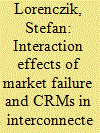

|
|
|
|
|
| Summary/Abstract |
European electricity markets are characterised by a multitude of (mainly national) approaches for ensuring security of supply. Although concerns regarding possible interaction effects between different market designs have been raised occasionally, the scientific research on capacity remuneration mechanisms (CRMs) primarily focusses on different design options in single markets. The research concerning possible spsill-over effects, positive or negative, in adjacent markets is lagging behind. This is the case for the effects of CRMs as well as for the effects of insufficient investment incentives. We address both topics in this paper.
|
|
|
|
|
|
|
|
|
|
|
|
|
|
|
|
| 6 |
ID:
097455
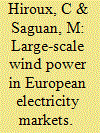

|
|
|
|
|
| Publication |
2010.
|
| Summary/Abstract |
This paper questions whether current renewable support schemes and electricity market designs are well-suited to host a significant amount of wind energy. Our analysis aims at finding the right equilibrium between market signals received by wind generators and their intrinsic risks. More market signals are needed to give the right incentives for reducing wind integration costs but should not undermine the effectiveness of support schemes. Although several alternatives combining support schemes and market signals could improve the current situation in terms of market signals and risks, feed-in premium support scheme seems actually to be the more balanced option. Furthermore, an adequate sharing of wind generation technical responsibility between the system operator and wind power producers can help to control wind integration costs even in the absence of accurate market signals.
|
|
|
|
|
|
|
|
|
|
|
|
|
|
|
|
| 7 |
ID:
096612


|
|
|
|
|
| Publication |
2010.
|
| Summary/Abstract |
This paper questions whether current renewable support schemes and electricity market designs are well-suited to host a significant amount of wind energy. Our analysis aims at finding the right equilibrium between market signals received by wind generators and their intrinsic risks. More market signals are needed to give the right incentives for reducing wind integration costs but should not undermine the effectiveness of support schemes. Although several alternatives combining support schemes and market signals could improve the current situation in terms of market signals and risks, feed-in premium support scheme seems actually to be the more balanced option. Furthermore, an adequate sharing of wind generation technical responsibility between the system operator and wind power producers can help to control wind integration costs even in the absence of accurate market signals.
|
|
|
|
|
|
|
|
|
|
|
|
|
|
|
|
| 8 |
ID:
177321
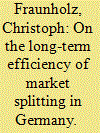

|
|
|
|
|
| Summary/Abstract |
In Europe, the ongoing renewable expansion and delays in the planned grid extension have intensified the discussion about an adequate electricity market design. Against this background, we jointly apply an agent-based electricity market model and an optimal power flow model to investigate the long-term impacts of splitting the German market area into two price zones. Our approach allows capturing long-term investment and short-term market behavior under imperfect information. We find strong impacts of a German market splitting on electricity prices, expansion planning of generators and required congestion management. While the congestion volumes decrease significantly under a market split in the short term, the optimal zonal configuration for 2020 becomes outdated over time due to dynamic effects like grid extension, renewable expansion and new power plant investments. Policymakers and regulators should therefore regularly re-assess bidding zone configurations. Yet, this stands in contrast to the major objective of price zones to create stable locational investment incentives.
|
|
|
|
|
|
|
|
|
|
|
|
|
|
|
|
| 9 |
ID:
190593


|
|
|
|
|
| Summary/Abstract |
Across several power systems with market frameworks, policy-makers are proposing that balancing flexibility requirements emerging during energy transition be addressed through new reserve product markets. However, these may introduce additional costs, constraints and complexity, and even encroach upon the functions of existing operational practices. Thus, policy-makers need to assess and compare flexibility design options, and quantifying system flexibility capabilities based on current and expected resource mixes can assist in achieving this. In this article, we offer a practical method to quantify the time-varying spectrum of upwards and downwards flexibility capabilities in systems, and subsequently apply it to historical and projected resource mixes in two regions of the Australian National Electricity Market. Our results suggest that with higher penetrations of renewable energy: (1) downwards flexibility margins can be exhausted around noon if wind and solar are unable or unwilling to provide it, (2) upwards flexibility becomes more scarce during morning and evening peak demand events and (3) a greater portion of upwards flexibility is provided by energy-limited resources. Given these trends, we recommend that policy-makers examine how existing operational practices can be augmented to elicit upwards flexibility provision, and that duration specifications and sustained footroom procurement be considered for reserve products.
|
|
|
|
|
|
|
|
|
|
|
|
|
|
|
|
| 10 |
ID:
096613


|
|
|
|
|
| Publication |
2010.
|
| Summary/Abstract |
This article focuses on the design of balancing markets in Europe taking into account an increasing wind power penetration. In several European countries, wind generation is so far not burdened with full balancing responsibility. However, the more wind power penetration, the less bearable for the system not to allocate balancing costs to the responsible parties. Given the variability and limited predictability of wind generation, full balancing exposure is however only feasible conditionally to well-functioning balancing markets. On that account, recommendations ensuring an optimal balancing market design are formulated and their impact on wind generation is assessed. Taking market-based or cost-reflective imbalance prices as the main objective, it is advised that: (1) the imbalance settlement should not contain penalties or power exchange prices, (2) capacity payments should be allocated to imbalanced BRPs via an additive component in the imbalance price and (3) a cap should be imposed on the amount of reserves. Efficient implementation of the proposed market design may require balancing markets being integrated across borders.
|
|
|
|
|
|
|
|
|
|
|
|
|
|
|
|
| 11 |
ID:
097456


|
|
|
|
|
| Publication |
2010.
|
| Summary/Abstract |
This article focuses on the design of balancing markets in Europe taking into account an increasing wind power penetration. In several European countries, wind generation is so far not burdened with full balancing responsibility. However, the more wind power penetration, the less bearable for the system not to allocate balancing costs to the responsible parties. Given the variability and limited predictability of wind generation, full balancing exposure is however only feasible conditionally to well-functioning balancing markets. On that account, recommendations ensuring an optimal balancing market design are formulated and their impact on wind generation is assessed. Taking market-based or cost-reflective imbalance prices as the main objective, it is advised that: (1) the imbalance settlement should not contain penalties or power exchange prices, (2) capacity payments should be allocated to imbalanced BRPs via an additive component in the imbalance price and (3) a cap should be imposed on the amount of reserves. Efficient implementation of the proposed market design may require balancing markets being integrated across borders.
|
|
|
|
|
|
|
|
|
|
|
|
|
|
|
|
| 12 |
ID:
169723


|
|
|
|
|
| Summary/Abstract |
Using reliability differentiation via tolling agreements with diverse heat rates and fuel types, we propose an efficient wholesale electricity market design under demand and supply uncertainty. Mainly based on North America's market experience, our proposed design adopts an independent system operator's (ISO's) existing practice of least-cost dispatch of heterogeneous generation units, real-time energy price determination and capacity rationing. It solves the missing money problem of inadequate incentive for thermal generation investment, without requiring the ISO to operate centralized capacity auctions, make capacity payments, set high energy price caps, or subsidize market entry. It preempts independent power producers' price manipulation in the ISO's real-time market for energy, thus easing the ISO's burden of market monitoring. It suggests two-part pricing of end-use consumption and power demand of a load serving entity's retail customers, thus meaningfully linking the wholesale and retail markets. It is applicable to countries that have implemented wholesale competition or are in the process of doing so. Hence, its policy implication is that it should be considered in the ongoing debate of electricity reliability and market competition.
|
|
|
|
|
|
|
|
|
|
|
|
|
|
|
|
| 13 |
ID:
166705
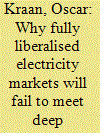

|
|
|
|
|
| Summary/Abstract |
Full decarbonisation of the electricity system is one of the key elements to limit global warming. As this transition takes place, the electricity system must maintain system adequacy and remain affordable to consumers. In liberalised electricity markets investors are seen as key actors driving this transition.
|
|
|
|
|
|
|
|
|
|
|
|
|
|
|
|
|
|
|
|
|